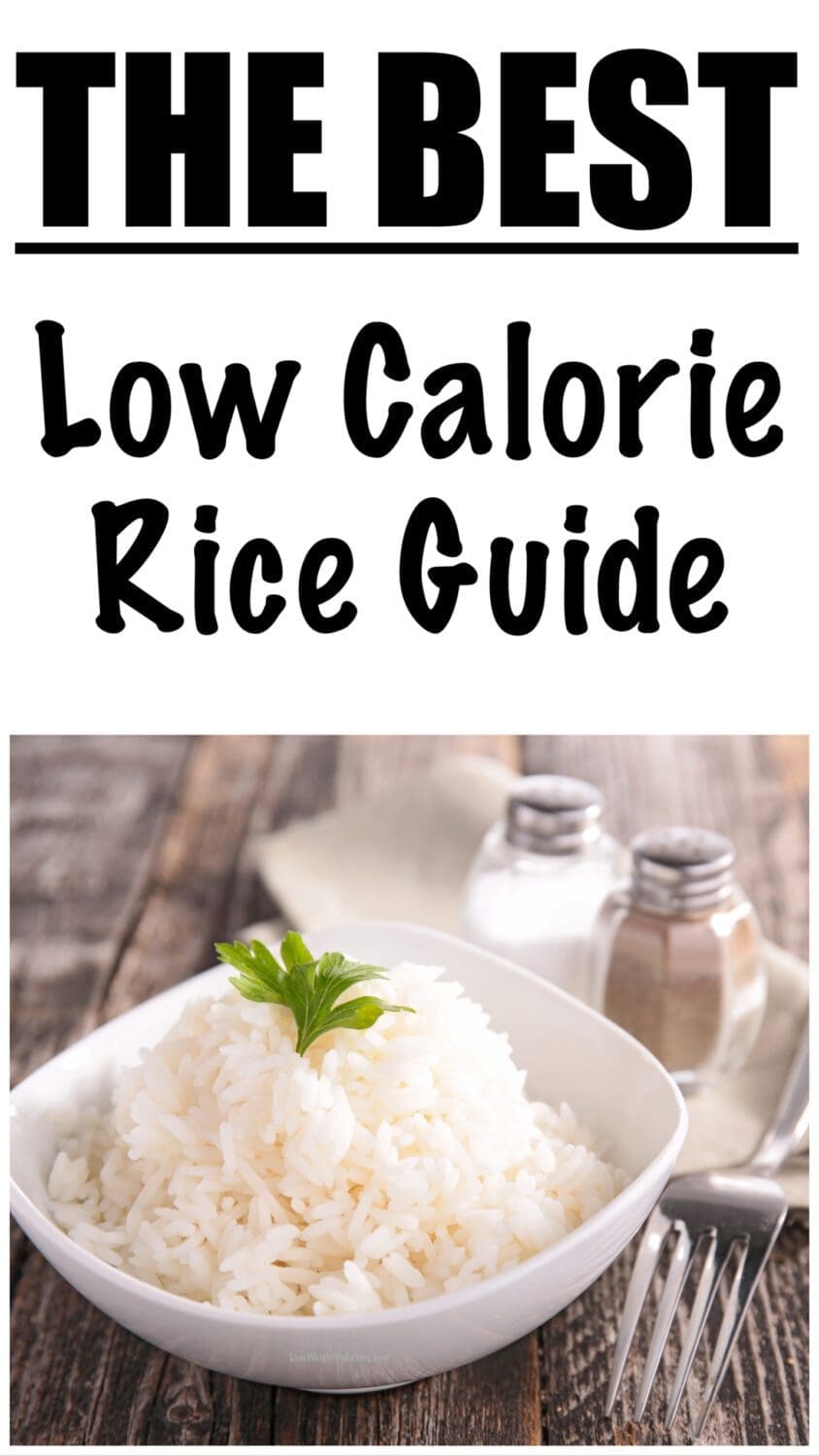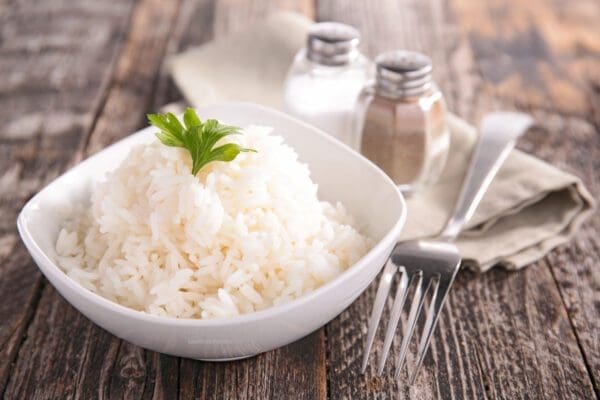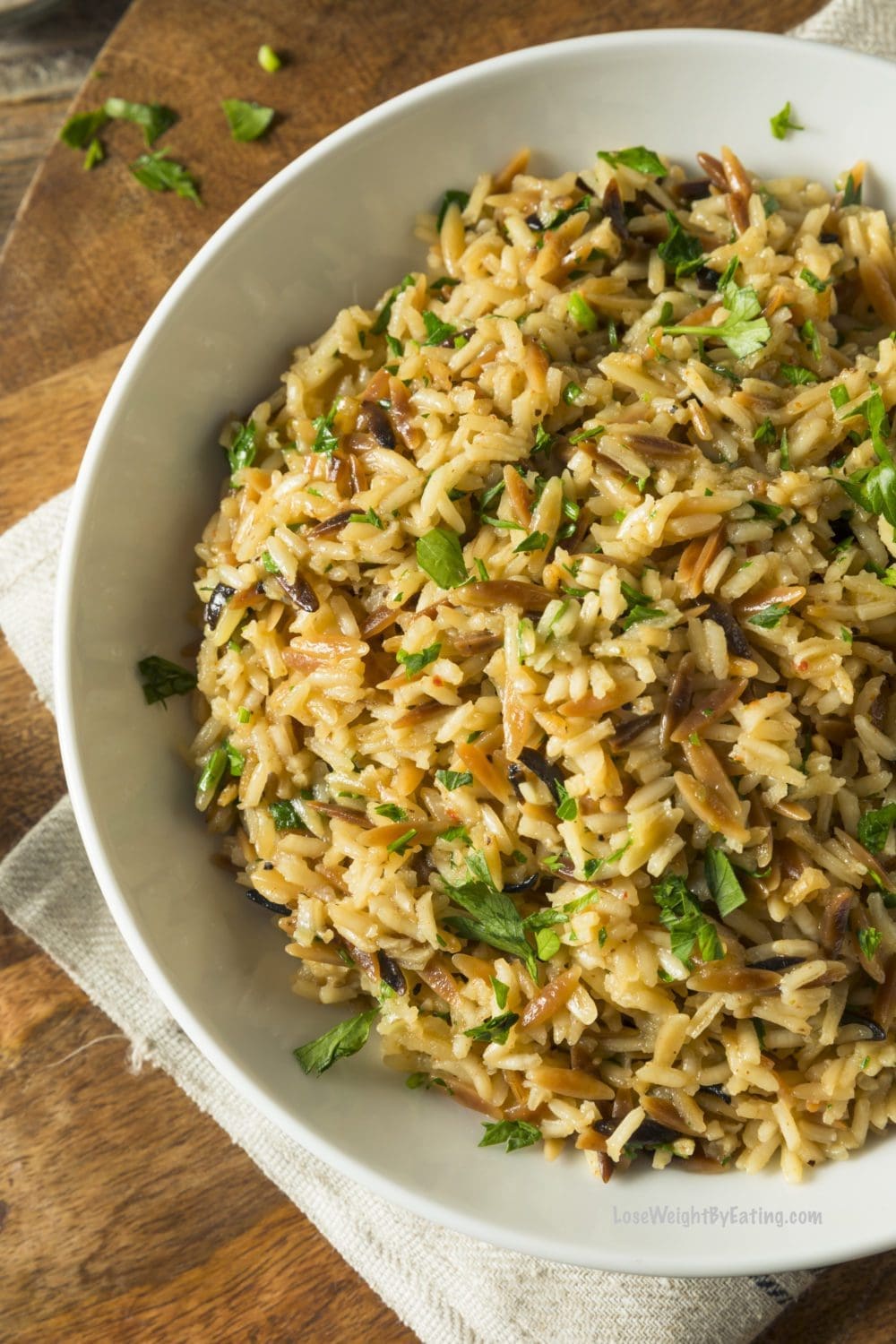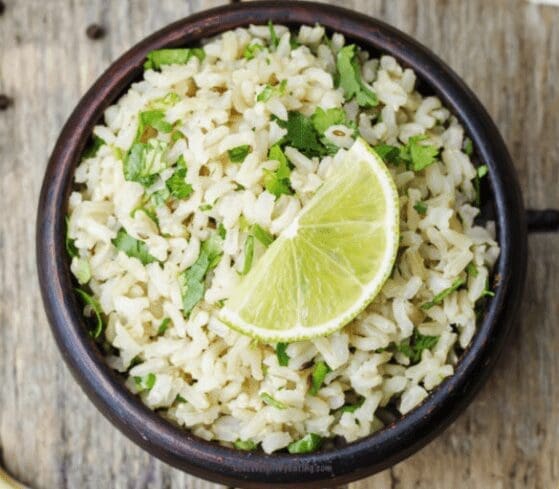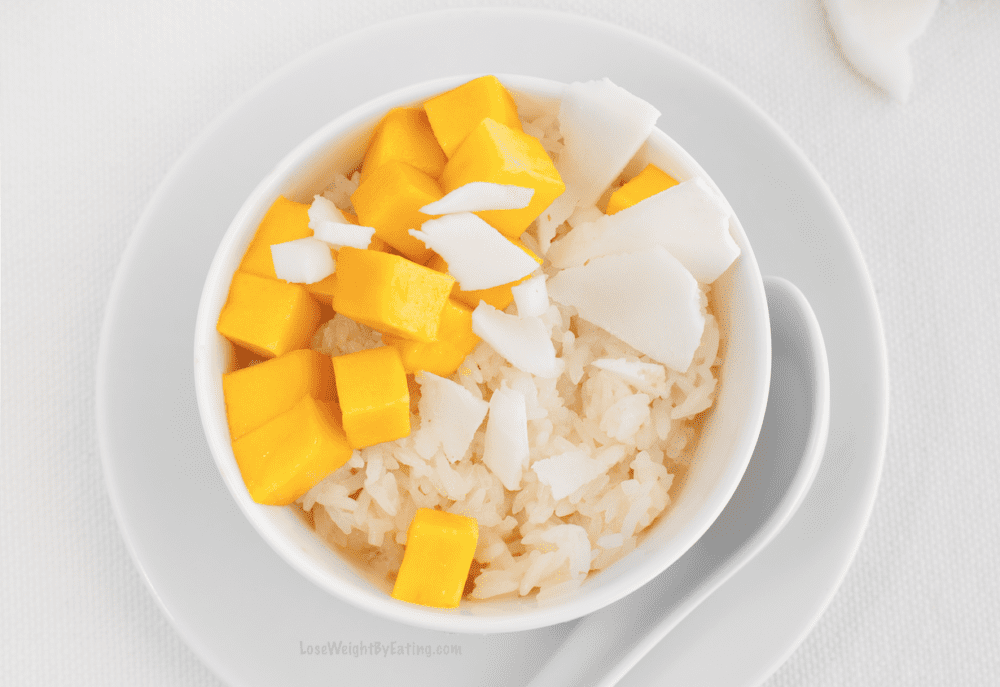This guide will supply you with Calories in 1 Cup of Cooked Rice for white, brown, jasmine, basmati, black and wild rice. And since they are different calories, I have also supplied you with a guide to the lowest calorie rice.
Rice is a staple food for millions of people around the world. It is easy to prepare, inexpensive, and versatile.
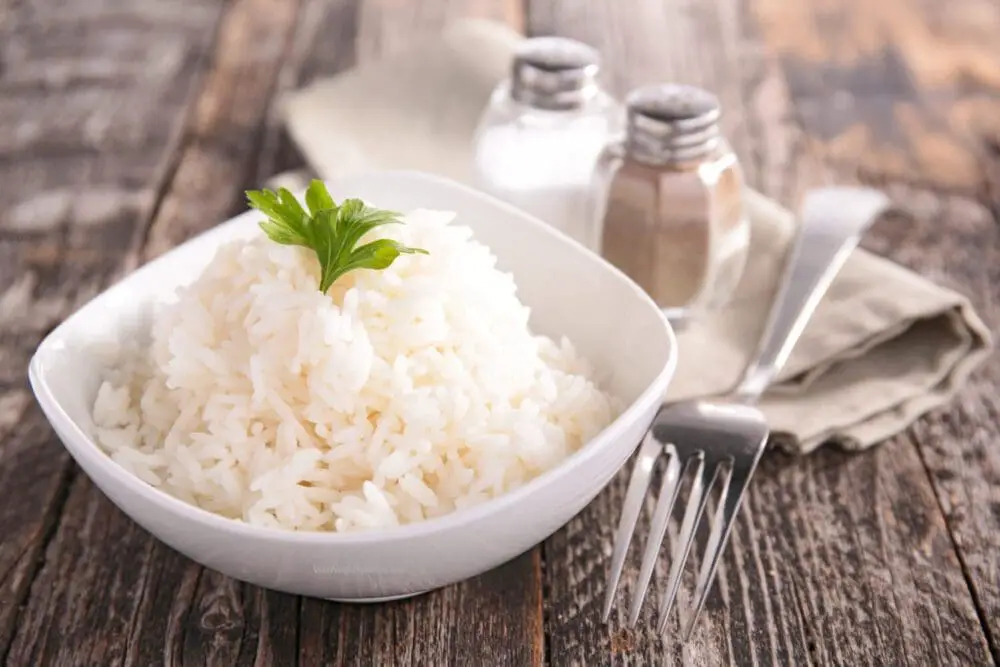

However, if you are watching your calorie intake, you may be wondering how many calories are in 1 cup of cooked rice.
The answer depends on the type of rice and how it is prepared. In this article, we will explore the calorie content of 1 cup of cooked rice and provide tips on how to incorporate rice into a healthy diet.
Is 1 Cup of Cooked Rice Healthy?
Rice is a good source of carbohydrates, which provide energy for the body. However, it’s essential to consume rice in moderation, as 1 cup of cooked rice can contain a significant number of calories. Additionally, some types of rice, such as white rice, are highly processed, which can strip them of some essential nutrients.
However, there are also many health benefits to consuming rice, especially if you choose whole grain varieties. Brown rice, for example, is an excellent source of fiber, which can help promote healthy digestion and prevent chronic diseases like heart disease and diabetes. It also contains essential vitamins and minerals, such as magnesium, phosphorus, and selenium.
Furthermore, rice is a gluten-free grain, making it a suitable option for people with celiac disease or gluten intolerance. It is also easy to digest, making it an excellent option for people with sensitive stomachs.
One cup of cooked rice can be a healthy addition to your diet, as long as it is consumed in moderation and paired with other nutritious foods. Choosing whole grain varieties and using healthier cooking methods, such as boiling or steaming, can also help maximize rice’s nutritional benefits.
Health Benefits of Rice
Rice is a staple food in many cultures and provides several health benefits. Here are some of the ways that rice can support overall health and well-being:
- Good source of energy: Rice is a high-carbohydrate food, which means it can provide a quick source of energy for the body. This can be especially beneficial for athletes or people with active lifestyles.
- Supports digestive health: Rice is easy to digest and can help support healthy digestion. Additionally, brown rice is an excellent source of fiber, which can promote regularity and prevent constipation.
- Provides essential vitamins and minerals: Rice contains several essential vitamins and minerals, including magnesium, phosphorus, and selenium. These nutrients are important for maintaining healthy bones, supporting the immune system, and promoting overall well-being.
- Gluten-free: Rice is naturally gluten-free, making it an excellent option for people with celiac disease or gluten intolerance.
- Can help lower cholesterol: Brown rice, in particular, has been shown to help lower cholesterol levels in the body. This is because it contains compounds called lignans, which can help reduce the absorption of cholesterol.
- May reduce the risk of chronic diseases: Some studies have suggested that consuming rice may help reduce the risk of chronic diseases like heart disease, diabetes, and certain types of cancer. This is likely due to its high fiber content and other nutrients.
Overall, rice is a nutritious and versatile food that can provide several health benefits. By choosing whole grain varieties and incorporating rice into a well-balanced diet, you can support overall health and well-being.
What is the Lowest Calorie Rice?
Rice is a staple food for many people around the world and can be a great source of energy and nutrients. However, some rice varieties are higher in calories and carbohydrates than others. If you are looking for a rice option that is lower in calories, here are some of the best options to consider:
- Wild Rice: Wild rice is a type of grass that is native to North America. It has a nutty flavor and a chewy texture and is lower in calories and carbohydrates than many other types of rice. One cup of cooked wild rice contains around 166 calories.
- Brown Rice: Brown rice is a whole grain rice that is less processed than white rice, and as a result, it retains more of its nutrients and fiber content. One cup of cooked brown rice contains around 216 calories.
- Black Rice: Also known as forbidden rice, black rice is a type of whole grain rice that is native to China. It is lower in calories and carbohydrates than many other types of rice and is also a good source of antioxidants. One cup of cooked black rice contains around 200 calories.
- Basmati Rice: Basmati rice is a type of long-grain rice that is commonly used in Indian and Middle Eastern cuisine. It has a fragrant aroma and a nutty flavor and is lower in calories and carbohydrates than many other types of rice. One cup of cooked basmati rice contains around 170 calories.
- Jasmine Rice: Jasmine rice is a type of long-grain rice that is commonly used in Thai cuisine. It has a fragrant aroma and a soft, sticky texture and is lower in calories and carbohydrates than many other types of rice. One cup of cooked jasmine rice contains around 205 calories.
If you are looking for a rice option that is lower in calories, there are several great options to consider. Wild rice, brown rice, black rice, basmati rice, and jasmine rice are all good choices that can provide a range of flavors and textures while also helping you stay within your calorie goals.
Calories in 1 Cup of Cooked Rice:
The number of calories in 1 cup of cooked rice varies depending on the type of rice. Here are some common types of rice and their calorie content per cup:
Calories in 1 cup of Cooked Rice:
- White rice: 205 calories
- Brown rice: 216 calories
- Basmati rice: 190 calories
- Jasmine rice: 205 calories
- Wild Rice: 155 calories
- Black rice: 200 calories
It’s important to note that the calorie content can also vary depending on how the rice is cooked. For example, adding butter or oil to the rice can increase its calorie content. Similarly, using a rice cooker can help retain more of the rice’s natural nutrients, which can affect its calorie content.
Nutritional Value of 1 Cup of White Rice
Keep in mind that the nutritional value of rice may vary depending on the type and preparation method. While white rice is a good source of carbohydrates, it is lower in fiber and nutrients compared to other types of rice.
To increase the nutritional value of your rice, consider adding vegetables or protein-rich ingredients to your meal.
- Calories: 204
- Carbohydrates: 44.5 grams
- Protein: 4.2 grams
- Fat: 0.4 grams
- Fiber: 0.6 grams
- Sodium: 1 mg
- Potassium: 55 mg
- Iron: 1.5 mg
- Thiamin (Vitamin B1): 0.2 mg
- Niacin (Vitamin B3): 2.3 mg
- Folate (Vitamin B9): 15.6 mcg
- Selenium: 12.6 mcg
Nutritional Value of 1 Cup of Brown Rice
Brown rice is a healthier alternative to white rice as it is higher in fiber, vitamins, and minerals. It is a good source of complex carbohydrates, which provide energy for the body.
One cup of cooked brown rice contains a specific amount of calories, protein, carbohydrates, vitamins, and minerals that may contribute to a balanced diet.
- Calories: 216
- Carbohydrates: 44.8 grams
- Protein: 5.0 grams
- Fat: 1.8 grams
- Fiber: 3.5 grams
- Sodium: 10 mg
- Potassium: 84 mg
- Iron: 0.8 mg
- Thiamin (Vitamin B1): 0.3 mg
- Niacin (Vitamin B3): 4.3 mg
- Folate (Vitamin B9): 10.2 mcg
- Selenium: 19.1 mcg
Nutritional Value of 1 Cup of Basmati Rice
Basmati rice is a fragrant, long-grain rice that originated in the Indian subcontinent. It is a popular type of rice and is commonly used in a variety of dishes, especially in Indian and Middle Eastern cuisine.
One cup of cooked Basmati rice contains a specific amount of calories, protein, carbohydrates, vitamins, and minerals that may contribute to a balanced diet.
- Calories: 191
- Carbohydrates: 43 grams
- Protein: 4 grams
- Fat: 0.5 grams
- Fiber: 0.6 grams
- Sodium: 0 mg
- Potassium: 55 mg
- Iron: 1.5 mg
- Thiamin (Vitamin B1): 0.2 mg
- Niacin (Vitamin B3): 2.5 mg
- Folate (Vitamin B9): 9 mcg
- Selenium: 11.1 mcg
Nutritional Value of 1 Cup of Jasmine Rice
Jasmine rice is a type of long-grain rice that is commonly used in Southeast Asian cuisine. It has a distinctive aroma and flavor that sets it apart from other types of rice.
Like other types of rice, 1 cup of cooked Jasmine rice contains a specific amount of calories, protein, carbohydrates, vitamins, and minerals that may contribute to a balanced diet.
- Calories: 205
- Carbohydrates: 45 grams
- Protein: 4 grams
- Fat: 0.5 grams
- Fiber: 0.6 grams
- Sodium: 0 mg
- Potassium: 35 mg
- Iron: 1.2 mg
- Thiamin (Vitamin B1): 0.2 mg
- Niacin (Vitamin B3): 2.5 mg
- Folate (Vitamin B9): 4 mcg
- Selenium: 11.1 mcg
Nutritional Value of 1 Cup of Wild Rice
Wild rice is a nutritious food that provides a range of essential nutrients. In this section, you’ll find a breakdown of the nutritional value of 1 cup of cooked wild rice.
Like other types of rice, wild rice is rich in carbohydrates and has a moderate amount of protein. However, it also contains higher amounts of certain nutrients like magnesium and zinc compared to other types of rice. Additionally, wild rice is a good source of dietary fiber, making it a healthy addition to any diet.
- Calories: 166
- Protein: 6.5 grams
- Carbohydrates: 35 grams
- Fiber: 3 grams
- Fat: 0.6 grams
- Sodium: 7.5 milligrams
- Potassium: 166 milligrams
- Iron: 1.3 milligrams
- Calcium: 11 milligrams
- Magnesium: 44 milligrams
- Zinc: 0.9 milligrams
Nutritional Value of 1 Cup of Black Rice
Black rice is a type of whole grain rice that is commonly used in Asian cuisine. It has a distinct, nutty flavor and a slightly chewy texture. In this section, you’ll find a breakdown of the nutritional value of 1 cup of cooked black rice.
- Calories: 160
- Protein: 5 grams
- Carbohydrates: 35 grams
- Fiber: 2 grams
- Fat: 2 grams
- Sodium: 2 milligrams
- Potassium: 160 milligrams
- Iron: 1.5 milligrams
- Calcium: 15 milligrams
- Magnesium: 160 milligrams
- Zinc: 1.3 milligrams
How to Incorporate Rice into a Healthy Diet:
While rice can be high in calories, it can still be part of a healthy diet if consumed in moderation. Here are some tips on how to incorporate rice into your diet while keeping your calorie intake in check:
- Pair rice with lean protein: Adding lean protein like chicken, fish, or tofu to your rice can make it more filling and satisfying. This can help prevent overeating and keep your calorie intake in check.
- Use small portions: A serving of rice is typically 1/2 cup, which contains around 100 calories. Using smaller portions can help you enjoy rice without overdoing it on calories.
- Choose healthier cooking methods: Instead of frying or adding butter to your rice, consider cooking it in vegetable broth or boiling it in water. This can help reduce the calorie content while adding flavor and nutrients.
- Add veggies: Adding vegetables like peas, carrots, or peppers to your rice can make it more nutritious and filling. This can help you consume fewer calories while still feeling satisfied.
Is 1 Cup of Rice Too Much?
The answer to this question depends on several factors, including your individual calorie needs, activity level, and overall diet.
In general, 1 cup of cooked rice contains around 200-240 calories, depending on the variety of rice. For many people, this can be a reasonable portion size, especially when paired with other nutritious foods like vegetables, lean proteins, and healthy fats.
However, if you are trying to lose weight or are on a calorie-restricted diet, 1 cup of rice may be too much. In this case, you may want to consider reducing your portion size or choosing lower-calorie alternatives like cauliflower rice or quinoa.
It’s also important to consider the quality of the rice you are consuming. Highly processed white rice may not be as nutritious as whole grain varieties like brown rice, black rice, or wild rice. Whole grain varieties contain more fiber, vitamins, and minerals, making them a healthier option overall.
Additionally, the way you cook your rice can impact its nutritional value. Boiling or steaming rice is a healthier option than frying or sautéing it, which can add unnecessary calories and unhealthy fats.
Overall, 1 cup of rice can be a reasonable portion size for many people, as long as it fits into a well-balanced diet and lifestyle. By choosing whole grain varieties, monitoring your portion sizes, and preparing rice in a healthy way, you can enjoy this nutritious and versatile food without overdoing it.
Is White Rice Good for Weight Loss?
White rice is a high-carbohydrate food that is often associated with weight gain, rather than weight loss. However, the relationship between white rice and weight loss is more complicated than it may seem.
On one hand, white rice is a calorie-dense food that can contribute to weight gain if consumed in excess. Additionally, white rice has a high glycemic index, which means it can cause rapid spikes in blood sugar levels. This can lead to cravings, overeating, and weight gain over time.
However, it’s also important to consider the overall context of your diet and lifestyle. If you are consuming white rice as part of a balanced diet that includes plenty of fruits, vegetables, lean proteins, and healthy fats, it may not have a significant impact on your weight.
Additionally, portion size and cooking method can also impact the potential weight loss benefits of white rice. Choosing a smaller portion size of white rice and pairing it with nutrient-dense foods can help balance out its calorie content. Cooking white rice in a healthier way, such as boiling or steaming instead of frying, can also help reduce its calorie content and make it a better option for weight loss.
Finally, it’s worth noting that there are other varieties of rice that may be better for weight loss than white rice. Brown rice, for example, is a whole grain that is higher in fiber, vitamins, and minerals than white rice. This can help promote feelings of fullness and prevent overeating, making it a better option for weight loss.
White rice can be part of a healthy diet in moderation, but it’s important to consider portion size, cooking method, and overall dietary context. By choosing nutrient-dense foods, monitoring portion sizes, and preparing white rice in a healthy way, you can enjoy its flavor and versatility without compromising your weight loss goals.
What is 1 Healthy Serving of Cooked Rice?
The definition of a healthy serving of cooked rice can vary depending on individual calorie needs and dietary goals. However, as a general rule of thumb, one serving of cooked rice is usually considered to be 1/2 cup or 1 cup, depending on the individual’s needs.
For example, if you are trying to lose weight or are on a calorie-restricted diet, you may want to aim for a smaller portion size of 1/2 cup of cooked rice, which contains around 100-120 calories. On the other hand, if you have higher calorie needs or are looking to gain weight, a larger portion size of 1 cup of cooked rice may be more appropriate, which contains around 200-240 calories.
It’s also important to consider the quality of the rice you are consuming. Choosing whole grain varieties like brown rice, black rice, or wild rice can provide more fiber, vitamins, and minerals than highly processed white rice. Additionally, cooking your rice in a healthy way, such as boiling or steaming, can help preserve its nutritional content and prevent the addition of unnecessary calories or unhealthy fats.
In addition to considering portion size and rice quality, it’s also important to pair your rice with other nutritious foods to make a well-balanced meal. Vegetables, lean proteins, and healthy fats can all help provide a range of nutrients and balance out the calorie content of your meal.
A healthy serving of cooked rice can vary depending on individual needs and goals. As a general guideline, 1/2 cup or 1 cup of cooked rice can be a reasonable portion size, depending on calorie needs. By choosing whole grain varieties, cooking rice in a healthy way, and pairing it with other nutritious foods, you can enjoy this versatile and nutritious food as part of a healthy diet.
Low Calorie Rice Recipes
Frequently Asked Questions (FAQ)
No, different types of rice have different calorie counts. For example, brown rice and wild rice have more calories than white rice.
The number of calories in 1 cup of cooked rice varies depending on the type of rice. White rice has approximately 200 calories per cup, while brown rice has around 220 calories per cup.
Yes, rice can be a part of a healthy and balanced weight loss diet as long as it is consumed in moderation and as part of a varied diet.
The number of calories in rice should be considered as part of an overall healthy and balanced diet. While rice is a good source of carbohydrates, it is important to balance it with other nutrient-dense foods such as vegetables, fruits, and lean protein sources.
Final Thoughts
Rice is a staple food in many cultures and is consumed in various forms all around the world. It is a good source of carbohydrates and can be a part of a healthy and balanced diet.
However, it is important to keep track of the calories in rice as different types of rice have different calorie counts. One cup of cooked white rice has approximately 200 calories, while one cup of cooked brown rice has around 220 calories.
It is important to consume rice in moderation and as part of a varied diet that includes nutrient-dense foods such as vegetables, fruits, and lean protein sources.
It is also important to note that the nutritional value of rice can vary depending on the type of rice. For example, brown rice and wild rice have more fiber and protein than white rice.
Black rice is a good source of iron, magnesium, and zinc. Basmati rice has a lower glycemic index compared to other types of rice. Jasmine rice is low in fat and sodium. Understanding the nutritional value of different types of rice can help you make informed choices about the types of rice you consume.
While the number of calories in rice should be considered as part of an overall healthy and balanced diet, it is important to also take into account the nutritional value of different types of rice. By consuming rice in moderation and as part of a varied diet, you can enjoy its health benefits while still maintaining a healthy weight and lifestyle.
What to Read Next:




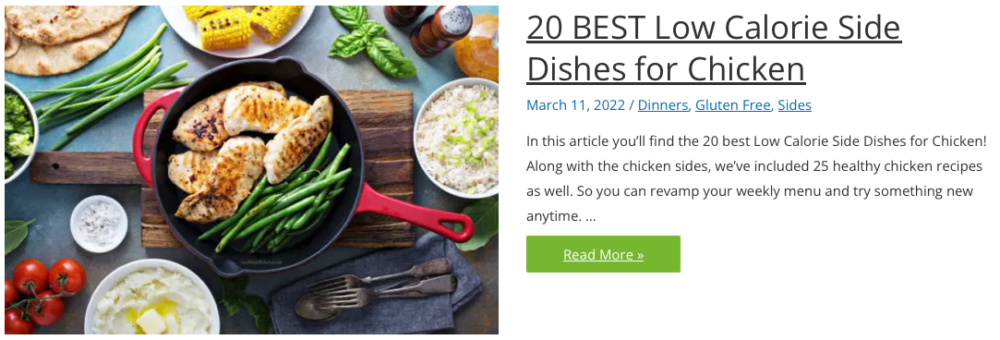

Lose Weight By Eating Cookbooks


Share this Low Calorie Guide:
